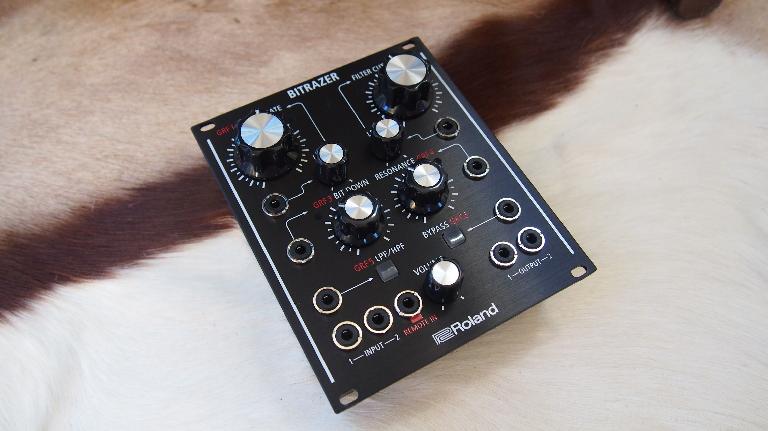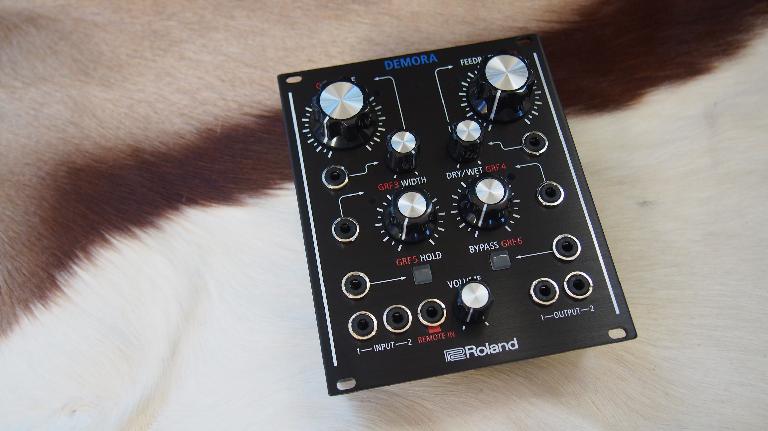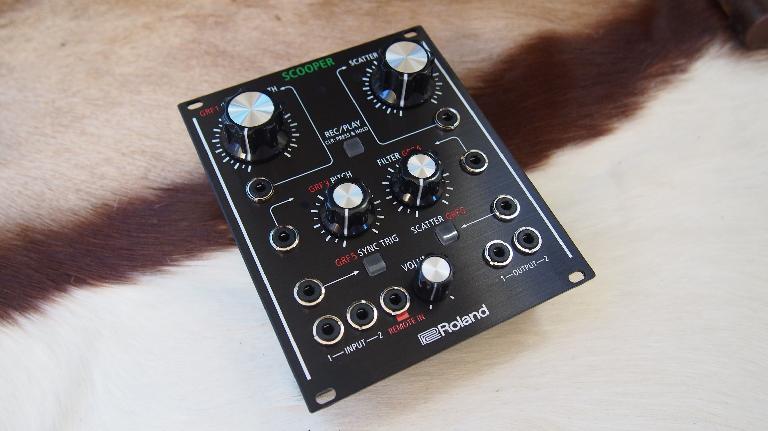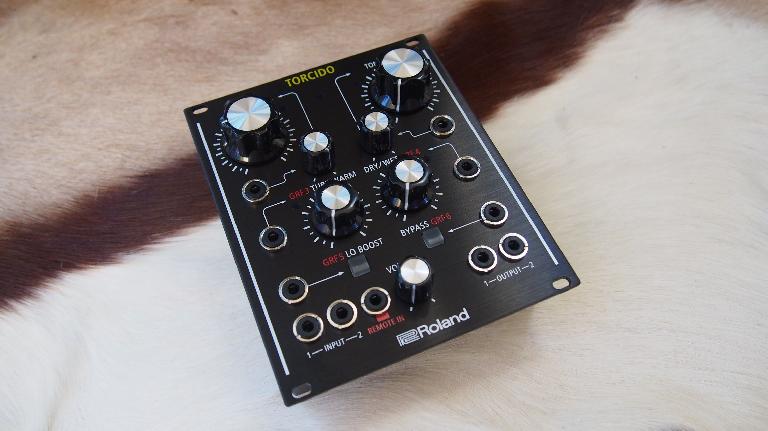Part of Roland’s return to the modular world took the form of four effect units. Each piece was made to work both standalone as a tabletop unit, and as part of a eurorack system. Roland’s AIRA line features the use of their Analog Circuit Behaviour technology; taking Virtual Analog to the next level by digitally recreating hardware from the inside out. It was first employed in re-imaginings of classic pieces that took shape as the TR-8, TB-3, and VT-3. However with these effect units they’re creating something entirely new for Roland.
The AIRA modules look great all racked up together and possess a reassuring build quality with larger knobs for primary functions and smaller knobs for the attenuation and secondary features. Each unit features a USB connection that functions as a 24bit/96kHz audio interface, and also sends MIDI and Sync information. The controls boast a resolution of 16 million steps to avoid any audible stepping or aliasing and ensure smooth sweeps as you twiddle and tweak.
Squeezed into the 21HP footprint are 11 patch points, 7 knobs, and 2 buttons; except in the case of the Scooper, which has 5 knobs and 3 buttons. Each unit has a dedicated volume knob, so you can quickly control the level of your signal. The 1/8” dual mono inputs make them compatible with a eurorack setup, but limit their intended use as tabletop effect boxes with other equipment. Roland would probably benefit from offering or including an adaptor or cable that takes stereo 1/4” and/or RCA connections and outputs dual 1/8”, similar to Elektron’s Audio/CV Split Cable Kit. To power the units, they cleverly come with both a standard wall wart, and a ribbon power adaptor.
The interesting thing about the AIRA modular line is that it can be reconfigured using a software editor for iOS, Android, and Mac/PC. Alterations can then be fed into the unit either via USB or as audio data through the Remote In. This means that after the stereo ins and outs, and the Remote In connection, you have 6 configurable inputs to play with. The software editor has a host of “virtual sub-modules” available to make this editing process more approachable. I’ll be taking a more detailed look at the software editor in a separate article, so for now, let’s focus on the units themselves and their functionality out of the box.
Bitrazer
First up we have Bitrazer, made for intense bit and sample rate crushing effects. This unit also features a selectable high or low pass filter with resonance. Somewhat counter-intuitively, the sample rate and bit down controls are most extreme counter-clockwise. Turning them clockwise increases the bit and sample resolutions, thereby reducing the extremity of the effect. Turned hard left, the bit reducer flattens your signal into a crude often inaudible square-wave. More subtle settings on the Sample Rate will introduce crispy smears of aliasing and harmonic distortion.
Audio Example 1—A triangle wave processed with Bitrazer:
Audio Example 2—A simple synth line processed with Bitrazer:
Demora
Next is Demora, the high-resolution delay featuring a massive range of 20 microseconds to 10 seconds. Shifting the delay time introduces pitch shifting, so you can get some pretty wacky sounds by modulating or playing with the timing. Short values can nicely thicken things, and with modulation you can get some great chorus or flanging. One feature I’d like to try implementing in the software editor would be a tempo sync input to lock the delay time to the tempo of a song or jam.
Audio Example 3—Synth line (first dry, then delayed and modulated):
Scooper
Scooper is billed as a single-pass loop recorder and Scatter effect. This guy is probably the most freaky and unpredictable of the bunch. Hitting the record button triggers recording, and you can either hit it again, or wait for the record buffer to fill before it starts to loop. At that point you can alter the pitch of the loop, filter it, and apply glitchy scatter effects. Rather than offering a Bypass button, this module has a toggle for the Scatter effect. Out of the box, this one was my least favourite because I found the scatter effect a little too chaotic, but I can see a lot of potential coolness potentially implemented through the editor.
Audio Example 4—Scooper is used to completely mangle the audio:
Torcido
Lastly we have the distortion module, Torcido. Made for classic Roland distortion ranging from gentle warm overdrive to heavy distortion. You can also use this module to effectively control how your tone sits in a mix by thinning things out with the tone control to help it cut, or hitting the bass boost to fill out your bass. The wet/dry knob makes it easy to season to taste, and you can also modulate this parameter. Just be aware that the signal will often be much hotter as it gets wetter, so you might find yourself riding the volume knob. One of my first tasks for the software editor will be to implement a limiter or compressor to keep the output level consistent.
Audio Example 5—Thinning the sound with Torcido:
Audio Example 6—Boosting the bass:
Audio Example 7—Modulation example:
In Conclusion
Out of the box the units are all fun, fairly straightforward to use, and sound great. Also they work great together, so you might find yourself wanting more than one. Arguably they are rather large and limited in function for what they do fresh from the factory at their price; however, judging them without considering the flexibility and benefits of their software editor is not completely fair, and frankly missing the point. I’m looking forward to exploring the digital versatility of these units and sharing my discoveries. I would also love to hear from those of you who have customized the AIRA modules to find out how you have taken advantage of the editor.
Audio Example 8—Hank Drum processed with Bitrazer and Torcido:
Audio Example 9—All 4 modules working together:
Price: $299 USD each.
Pros: Reconfigurable with software editor, Volume control for quick adjustment, USB Audio Interface,
Cons: On higher end of price point and size for out of box functionality








 © 2024 Ask.Audio
A NonLinear Educating Company
© 2024 Ask.Audio
A NonLinear Educating Company
Discussion
Want to join the discussion?
Create an account or login to get started!